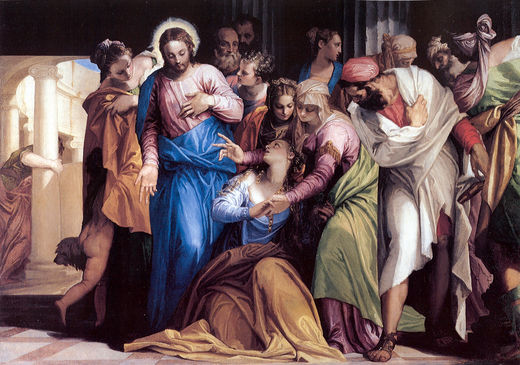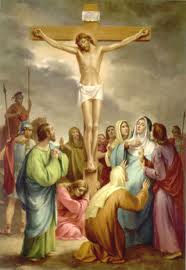There is probably no woman in the Bible that has been as misunderstood as Mary of Magdala, also called Mary Magdalene. The church has often portrayed her as the sinner who wiped Jesus’ feet with her hair. But that text in Luke’s Gospel does not name the woman, and it is not likely that the woman spoken of there is Mary. Others have thought that she is the woman taken in adultery in John’s Gospel. Again, there is no reason to suppose that. We really are not told much about her former life. We should be careful and see just what the Bible does say about her.
The apostle Luke first mentions Mary when he tells us about the women who were following Jesus and the disciples ministering to their needs. “There were twelve with Him and also some women who had been healed of evil spirits and sicknesses; Mary who was called Magdalene, from whom seven demons gone out and Joanna the wife of Chuza, Herod’s steward, and Susanna, and many others who were contributing to their support out of their private means.” (Luke 8:1-3) These women were above reproach. We can be sure that Jesus and his disciples would not do anything that would ruin their reputations. Jesus’ enemies were always looking for ways to accuse Him. But no one could ever make accusations against the Lord for the way He treated women. Jesus thought that it was important for women to be disciples and learn from Him. He was kind and cared for them. One of these women was Mary Magdalene. We are only told that Jesus cast seven demons out of her.
following Jesus and the disciples ministering to their needs. “There were twelve with Him and also some women who had been healed of evil spirits and sicknesses; Mary who was called Magdalene, from whom seven demons gone out and Joanna the wife of Chuza, Herod’s steward, and Susanna, and many others who were contributing to their support out of their private means.” (Luke 8:1-3) These women were above reproach. We can be sure that Jesus and his disciples would not do anything that would ruin their reputations. Jesus’ enemies were always looking for ways to accuse Him. But no one could ever make accusations against the Lord for the way He treated women. Jesus thought that it was important for women to be disciples and learn from Him. He was kind and cared for them. One of these women was Mary Magdalene. We are only told that Jesus cast seven demons out of her.
The subject of demon possession seems very foreign to our modern ears. We do not really understand it in our day, especially in our culture. There are other places in the world, such as Haiti, where people fool around with demons, but to most of us they just don’t seem real.
For people in the area of Magdala in the first century, demons were very real. Magdala was a fishing village near Capernaum on the shore of Galilee. Apparently this area was a hotbed of demonic activity. Jesus had already exorcised a number of demons in that region. This was the home-town of Mary of Magdala, more often known as Mary Magdalene.
Though it seems unbelievable to us, there really are fallen spirit creatures called demons that indwell afflicted individuals. We have several stories in the Bible where these demons even talk through the lips of the possessed person. Jesus confronted many demons and healed many people from them.
Notice that Jesus “healed” them. Scripture portrays demon possession as an affliction. While sin may have played a part in the demon possession, none of the demoniacs in the Bible is explicitly associated with immoral behavior. These men and women were seen as tormented, unwilling people suffering wretched indignities at the hand of evil spirits. They were miserable, forlorn, heartsick, and pitiable creatures. Often the demoniacs were insane. Most of them had various illnesses. They were shunned by society and so they were ill-nourished and very poor.
This was the life of Mary of Magdala when Jesus found her. Her demonic possession must have been very severe; she had seven demons. So, she had the strongest of reasons to love and follow the Savior. He had saved her from much. He rescued her from illness and torture. Since the Bible portrays those who were possessed as afflicted with illness, we have no reason to believe that Mary was involved in any immoral behavior either before or after she met Jesus. She was a faithful, grateful follower all the days of her life. Her love for Him and her gratitude for her healing enabled her to devote her life, along with some other women, to wholeheartedly serving Jesus. She voluntarily used her own means to do this.
 Mary was a very courageous disciple. When Jesus was arrested, tried, and crucified, she followed Him, and stayed near to Him right to the bitter end. We know that she was at the cross with other women. “But standing by the cross of Jesus were His mother, and His mother’s sister, Mary the wife of Clopas, and Mary Magdalene.” (John 19:25) We know that most of the other disciples had scattered, but Mary stayed close by.
Mary was a very courageous disciple. When Jesus was arrested, tried, and crucified, she followed Him, and stayed near to Him right to the bitter end. We know that she was at the cross with other women. “But standing by the cross of Jesus were His mother, and His mother’s sister, Mary the wife of Clopas, and Mary Magdalene.” (John 19:25) We know that most of the other disciples had scattered, but Mary stayed close by.
It must have been agonizing for her to watch the death of her beloved Lord. There was a mob there, screaming and shouting hatred at Christ. But she did not shrink away. She stayed close to Jesus to the end. When Joseph of Arimathea was given permission to bury Jesus, she followed him to see the tomb where Joseph took Him and how His body was laid. She went home and prepared some spices and perfumes, and then rested, because it was the Sabbath.
Early the next morning Mary went to the tomb bringing her spices with her. Imagine her surprise when the tomb was empty! She ran to tell the other disciples. Peter and John came. They saw the empty tomb, but they did not understand yet what was happening and so they went home. Mary stood outside the tomb weeping. She thought someone had come and stolen away the body of Jesus. But then, Jesus Himself came and spoke to her. At first, she did not recognize Him. “Mary,” He said. When she heard that beloved voice say her name she knew it was her Lord. She was so excited that she ran to tell the disciples, “I have seen the Lord.”
Jesus gave her a very special honor. She was the first person to see Him after He rose from the dead. Others had heard the announcement from angels, but Mary had the special honor to be the first to see and speak to Jesus Himself. “When He rose early on the first day of the week, He appeared first to Mary Magdalene.” (Mark 16:9)
rose from the dead. Others had heard the announcement from angels, but Mary had the special honor to be the first to see and speak to Jesus Himself. “When He rose early on the first day of the week, He appeared first to Mary Magdalene.” (Mark 16:9)
This was a special tribute paid to a faithful disciple. No one can ever share that honor with her or take it away from her. As women, we can and should try to imitate Mary in her deep love and commitment for Christ.
In our day, there are some really wild stories about Mary. You may often hear people criticize an immoral woman by calling her a “Mary Magdalene”. Popular books and movies portray her as a loose woman. One apocryphal movie even makes her out to have been the wife of Jesus. This is all blasphemous.
The next time you hear anyone say something negative about this gracious, godly woman, I hope you will straighten them out! The Scriptures portray her as an extraordinary person. Let’s not let the popular misconceptions prevail. Mary was actually a faithful Christian who let her profound gratitude and love for Christ show. May our lives be the same.

